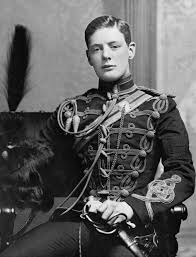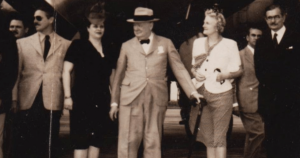 WINSTON CHURCHILL VIAJES A CUBA.
WINSTON CHURCHILL VIAJES A CUBA.
El viaje de Winston Churchill a Cuba en 1895, su primer viaje a Cuba,, fue más formativo de lo que se había creído según un nuevo libro, que dice que fue en Cuba donde el joven oficial de 20 años descubrió su temple guerrero y su propio sentido de grandeza.
En “Churchill Comes of Age: Cuba 1895”, el autor Hal Klepak indaga en la manifestación de muchas de las cualidades que distinguirían a Churchill en sus 18 días en Cuba, donde fue enviado por el ejército británico para observar el conflicto que enfrentaba a la España colonial contra los independentistas cubanos.
Arroyo Blanco, un pequeño pueblo en el este de la provincia de Sancti Spiritus, fue el destino y la base de Churchill cuando vino a observar la Guerra de Independencia de Cuba. Su viaje allí fue, como era de esperar dada su ubicación, bastante indirecto y largo.
La historia cuenta que Churchill, entonces un joven oficial en el 4to Húsar, decidió que necesitaba ver algo de acción. Tras graduarse en la academia militar Sandhurst, el teniente segundo quería desesperadamente una guerra para poner a prueba su valor y hacerse de un nombre. Churchill, cuyo padre acababa de morir, informó a su madre de sus planes para ir a la isla, más que pedir su permiso.
La única guerra en ese momento fue en Cuba, así que, una vez que obtuvo el permiso del gobierno español en Madrid, navegó a La Habana, tomó un tren a Cienfuegos, un bote a Tunas de Zaza y luego otro tren a Sancti Spiritus donde él se unió al ejército español, bajo el liderazgo del general Suárez Valdés.
La historia anterior sostiene que Churchill observó combates en Cuba y descubrió la siesta, que luego le ayudaría como primer ministro británico a mantenerse activo durante las largas horas de la Segunda Guerra Mundial.

En Cuba se inició como corresponsal de guerra, analista político, estratega y enlace con un ejército extranjero, todo por primera vez. Sus escritos comenzaron a mostrar su distintivo sentido del humor y descubrió el ron y la calidad de los cigarros cubanos.
Pero el escritor H. Klepak, un ex oficial del ejército canadiense, sostiene que trabajos anteriores descuidaron la influencia de la aventura cubana, incluyendo los varios de meses de preparación para llegar a su misión. Klepak piensa que ha sido el primero en examinar y contrastar los archivos cubanos, británicos y españoles, descubriendo, por ejemplo, que Churchill fue testigo del ataque de dos líderes de la independencia de Cuba contra España: Antonio Maceo y Máximo Gómez.
“Muy rápidamente, al mirarlo desde una perspectiva histórica, era bastante obvio que se trataba de una historia sorprendente, la cual por alguna razón no se había comentado nunca”, dijo Klepak.
Fue en Arroyo Blanco, en la hoy provincia de Sancti Spiritus, donde el entonces teniente Churchill pasó la prueba, sin retroceder cuando las columnas españolas a las que acompañaba fueron atacadas por las tropas independentistas. “Fue su bautismo de fuego y también coincidió con su vigésimo primer cumpleaños”, dijo Klepak. “Literalmente llegó a la mayoría de edad y en una decena de aspectos también llegó a la mayoría de edad”.
Churchill en este su primer viaje a Cuba pasó solo unas pocas semanas y salió de La Habana el 14 de diciembre de 1895.
La segunda visita de Churchill a Cuba fue después de la Segunda Guerra Mundial cuando, ya no primer ministro, viajó a través del Atlántico por invitación del presidente estadounidense Truman. En La Habana se alojó en el famoso Hotel Nacional, que aún hoy tiene un Bar Churchill, nombrado en su honor.
 WINSTON CHURCHILL TRIPS TO CUBA.
WINSTON CHURCHILL TRIPS TO CUBA.
Winston Churchill’s trip to Cuba in 1895, his first trip to Cuba, was more formative than had been believed according to a new book, which says it was in Cuba where the young 20-year-old officer discovered his warrior temper and his own sense of greatness.
In “Churchill Comes of Age: Cuba 1895”, author Hal Klepak inquires into the manifestation of many of the qualities that would distinguish Churchill in his 18 days in Cuba, where he was sent by the British army to observe the conflict facing Colonial Spain against the Cuban independentists.
Arroyo Blanco, a small town in the east of the province of Sancti Spiritus, was the destination and base of Churchill when he came to observe the Cuban War of Independence. His trip there was, as expected, given its location, quite indirect and long.
The story goes that Churchill, then a young officer in the 4th Hussar, decided that he needed to see some action. After graduating from Sandhurst military academy, the second lieutenant desperately wanted a war to test his courage and make a name for himself. Churchill, whose father had just died, informed his mother of his plans to go to the island, rather than asking for his permission.
The only war at that time was in Cuba, so, once he obtained permission from the Spanish government in Madrid, he sailed to Havana, took a train to Cienfuegos, a boat to Tunas de Zaza and then another train to Sancti Spiritus where he joined the Spanish army, under the leadership of General Suárez Valdés.
The previous story argues that Churchill observed fighting in Cuba and discovered the siesta, which would then help him as the British Prime Minister to remain active during the long hours of World War II.
In Cuba, he began as a war correspondent, political analyst, strategist and liaison with a foreign army, all for the first time. His writings began to show his distinctive sense of humor and he discovered rum and the quality of Cuban cigars.
But the writer H. Klepak, a former Canadian army officer, argues that previous work neglected the influence of the Cuban adventure, including several months of preparation to reach his mission. Klepak thinks he was the first to examine and contrast the Cuban, British and Spanish archives, discovering, for example, that Churchill witnessed the attack of two Cuban independence leaders against Spain: Antonio Maceo and Máximo Gómez.
“Very quickly, when looking at it from a historical perspective, it was quite obvious that it was a surprising story, which for some reason had never been commented,” Klepak said.
It was in Arroyo Blanco, in the province of Sancti Spiritus today, that then-Lieutenant Churchill passed the test, without retreating when the Spanish columns he accompanied were attacked by the independence troops. “It was his baptism of fire and it also coincided with his twenty-first birthday,” Klepak said. “He literally came of age and in a dozen aspects he also came of age.”
Churchill on this his first trip to Cuba spent only a few weeks and left Havana on December 14, 1895.
Churchill’s second visit to Cuba was after World War II when, no longer prime minister, he traveled across the Atlantic at the invitation of US President Truman. In Havana, he stayed at the famous National Hotel, which still has a Churchill Bar, named in his honor.
Agencies/ RHC/ Reuters/ Daniel Trotta/ Pedro M. Otero/ Extractos/ Excerpts/ Internet Photos/ Arnoldo Varona/ www.TheCubanHistory.com
THE CUBAN HISTORY, HOLLYWOOD.














